Abstract
Accurate river ice mapping is crucial for predicting and managing floods caused by ice jams and for the safe operation of hydropower and water resource facilities. Although satellite multispectral images are widely used for river ice mapping, atmospheric contamination limits their effectiveness. This study developed river ice mapping models for the Han River in South Korea using atmospherically uncorrected Landsat-8 Operational Land Imager (OLI) multispectral reflectance data, addressing atmospheric influences with a Random Forest (RF) classification approach. The RF-based river ice mapping models were developed by implementing various combinations of input variables, incorporating the Landsat-8 multispectral top-of-atmosphere (TOA) reflectance, normalized difference indices for snow, water, and bare ice, and atmospheric factors such as aerosol optical depth, water vapor content, and ozone concentration from the Moderate Resolution Imaging Spectroradiometer observations, as well as surface elevation from the GLO-30 digital elevation model. The RF model developed using all variables achieved excellent performance in the classification of snow-covered ice, snow-free ice, and water, with an overall accuracy and kappa coefficient exceeding 98.4% and 0.98 for test samples, and higher than 83.7% and 0.75 when compared against reference river ice maps generated by manually interpreting the Landsat-8 images under various atmospheric conditions. The RF-based river ice mapping model for the atmospherically corrected Landsat-8 multispectral surface reflectance was also developed, but it showed very low performance under atmospheric conditions heavily contaminated by aerosol and water vapor. Aerosol optical depth and water vapor content were identified as the most important variables. This study demonstrates that multispectral reflectance data, despite atmospheric contamination, can be effectively used for river ice monitoring by applying machine learning with atmospheric auxiliary data to mitigate atmospheric effects.
1. Introduction
River ice plays a crucial role in the hydrology and ecology of cold region river systems, influencing water flow, riverine habitats, and human activities [1,2,3,4,5]. It can lead to the formation of ice jams, which may cause flooding, alter sediment transport, and affect water resource management and aquatic ecosystems [4,6,7,8]. Snow cover on river ice controls ice dynamics, ice jamming flood risks, and the timing of melt onset. Snow-free river ice absorbs more sunlight, leading to faster melting and an earlier spring break-up [9]. This type of ice can also pose unique hazards for winter navigation and infrastructure due to its transparency and potential for sudden fracture. Meanwhile, snow-covered river ice reflects more sunlight, resulting in slower melting processes [9,10]. The insulating properties of snow cover also impact the thermal regime of the ice, affecting its thickness and structural integrity. Snow-covered ice can mask the presence of underlying weak spots, creating unpredictable conditions for both wildlife and human activities. These differences make it imperative to accurately detect river ice and to distinguish between the two forms of ice in environmental monitoring and maintenance of infrastructure such as bridges and hydroelectric dams.
The Han River has the highest flow discharge and the largest basin area on the Korean Peninsula. It is the second longest river in South Korea and has significantly varying widths. The river crosses densely populated areas, including Seoul, the capital of South Korea, and serves as a water supply for over 12 million people. Additionally, the river is a habitat for various freshwater species and hosts water resource facilities such as dams for hydroelectric power, flood control, and water supply. During the winter season (December to February), the Han River freezes due to sustained sub-zero temperatures or the impact of cold waves. The timing, duration, and extent of the river’s freezing vary each year due to fluctuations in water depth, flow rate, pollution levels, and the impact of climate change [11]. Furthermore, the snow cover on the river ice varies significantly over time and space. These variations have a profound impact on water management, the operation of water resource facilities, and the safety of water activities in central South Korea. Therefore, detecting and classifying ice are crucial not only for the Han River but also for other cold regions.
Spaceborne remote sensing images with spatial and temporal resolutions of at least a few tens of meters and a few days, respectively, are necessary for the detection and classification of river ice, especially in narrow and long rivers, such as the Han River, where ice dynamics are dramatic. Satellite synthetic aperture radar (SAR) offers all-weather, day–night capabilities and sensitivity to surface textures, making it invaluable for continuous monitoring and structural analysis of river ice [12,13,14,15,16]. However, the radar backscattering of river ice is typically from its surface [14,17], and it can be difficult to distinguish thin ice or wet snow-covered ice, which typically forms in rivers in temperate climates, from water. Satellite optical sensors are highly useful for monitoring the dynamic and thermal characteristics of river ice by measuring reflectance and emissivity across various wavelength bands. Optical images, in particular, are intuitive and relatively easy to interpret, enabling effective river ice detection. Multispectral and hyperspectral images with spatial resolutions ranging from a few tens of centimeters to 1 km have been captured by various satellite optical sensors and are widely used for river ice monitoring [18,19,20,21,22,23,24,25,26,27,28,29,30,31]. Modern optical satellite data at resolutions of tens of meters, such as those from the Landsat series and Sentinel-2, provide high spatial and temporal resolution imagery that can capture detailed features of river ice, allowing for continuous monitoring of ice conditions. Many studies on river ice mapping and classification have been conducted using multispectral data from the Landsat series and Sentinel-2 [18,19,20,21,22,23]. Furthermore, many commercial very high-resolution optical satellites, such as PlanetScope, which are capable of observing highly detailed ice features and providing data accessible within hours, can be effectively utilized for river ice monitoring [24,25]. The effectiveness of satellite optical imagery is reduced under cloud cover and during night-time. Nevertheless, the multispectral data captured by optical sensors enable the differentiation of river ice from water and land, and the distinction between snow-free and snow-covered ice based on their spectral signatures.
The atmospheric effects on the multispectral reflectance of ice and water, which reduce ice monitoring performance, have been recognized as a significant challenge [21,32,33]. The joint efforts of the National Aeronautics and Space Administration, the United States Geological Survey (USGS), and Copernicus Services operationally provide atmospheric corrected surface reflectance products for Landsat and Sentinel-2, respectively. These corrections use atmospheric auxiliary data such as water vapor (WV) content, aerosol optical depth (AOD), and ozone (OZ) concentration [34,35,36]. Several studies have also used atmospherically corrected optical images to reduce inaccuracies in multispectral observations of river ice caused by atmospheric effects [20,21,30,31]. However, the correction accuracy for snow- and ice-covered regions with very high reflectivity, and water with low reflectivity, remains relatively low [37,38]. This limitation significantly affects river ice mapping and classification from multispectral data. Machine learning approaches can effectively address atmospheric influences on classification and regression tasks by learning from the multispectral and atmospheric auxiliary data, rather than relying directly on atmospheric corrected products [39]. Although machine learning methods for mitigating atmospheric effects could be applied to river ice mapping from multispectral data, no studies have yet explored this approach to the best of our knowledge.
The purpose of this study is to develop and evaluate river ice mapping models for the Han River in South Korea using Landsat-8 top-of-atmosphere (TOA) multispectral reflectance data through a machine learning approach. To account for atmospheric effects on the classification of ice and water, this study incorporates Moderate Resolution Imaging Spectroradiometer (MODIS)-derived atmospheric factors and surface elevation data from a digital elevation model (DEM) in the learning process. The performance of the river ice mapping models, developed using various input variable combinations, was assessed to determine the most effective scheme for accurately mapping river ice.
2. Materials
2.1. Study Area
The Han River is one of the major rivers in South Korea, stretching approximately 494 km and covering a watershed area of approximately 26,000 km2 (Figure 1). The Han River originates from the confluence of the two major tributaries, the Namhan River (South Han River) and the Bukhan River (North Han River). It flows westward through the capital city of Seoul and the metropolitan areas of the Gyeonggi Province, eventually emptying into the Yellow Sea after merging with the Imjin River. The width of the Han River varies significantly, ranging from tens of meters in its upper reaches to several kilometers wide in the lower sections. The river’s depth and flow rate are also variable, influenced by seasonal changes and weather conditions, which in turn affect river ice formation. The Han River freezes nearly every winter season, with the annual freezing period varying significantly (50.3 ± 30.6 days, [11]).
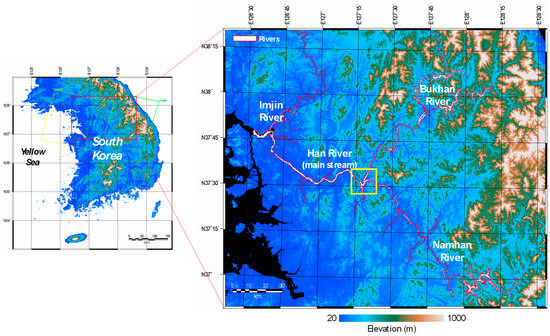
Figure 1.
Topography of the Han River region in South Korea. The green and yellow rectangles on the left topographic map represent the imaging coverage of Landsat-8 path/row 115/34 and 116/34, respectively. The yellow rectangle on the right map indicates the region of Paldang Lake, which serves as the test site for the river ice mapping models proposed in this study.
2.2. Landsat-8 OLI Data
Landsat-8 is the eighth generation of the Landsat mission, launched on 11 February 2013. Its payload consists of the Operational Land Imager (OLI) and the Thermal Infrared Sensor (TIRS) [40]. The OLI provides spectral data ranging from visible to shortwave infrared bands with a spatial resolution of 30 m, as well as a panchromatic band with a 15 m spatial resolution. The TIRS collects spectral data in thermal infrared bands with a spatial resolution of 100 m, which is registered to the OLI products and distributed with a grid size of 30 m. Landsat-8 has a swath width of 185 km and a revisit cycle of 16 days.
In this study, we used Landsat-8 OLI multispectral imagery (Bands 1–9, excluding Band 8 of the panchromatic image) capturing the Han River (path/row 115/34 and 116/34 of the Worldwide Reference System-2 [41]) during the winter seasons from 2014 to 2022 (Table 1). All Landsat-8 OLI images were collected as Level-1 Terrain Precision Correction (L1TP) products on days when river ice was visually identified in the RGB true-color composite images, and cloud cover, as indicated in the product metadata, was less than 20%. The Landsat-8 images were projected into the Universal Transverse Mercator (UTM) projection, zone 52 on the WGS84 ellipsoid. Images with cloud cover obscuring the Han River, even if less than 20%, were excluded from the study. As a result, a total of 23 Landast-8 OLI images were selected for analysis (Table 1).

Table 1.
Landsat-8 OLI data was used in this study. The mean aerosol optical depth (AOD), mean water vapor (WV) content, and mean ozone (OZ) concentration were derived from MODIS for the study area.
Additionally, we utilized Landsat-8 Level-2 Science Products (L2SP) provided by the USGS, which offer surface reflectance corrected for atmospheric effects, corresponding to the Landsat-8 L1TP products listed in Table 1. The Landsat-8 L2SP are generated using the Land Surface Reflectance Code (LaSRC) algorithm [34,42] for atmospheric correction. In this study, we aimed to develop and compare the performance of river ice mapping models based not only on TOA reflectance but also on surface reflectance derived from these L2SP products.
2.3. MODIS-Based Atmospheric Factors and GLO-30 DEM
AOD, WV content, OZ concentration, and surface elevation are key factors affecting the measurements of surface reflectance [34,37,43,44,45]. AOD primarily affects the visible and near-infrared bands through scattering by aerosols and fine particulates [46,47,48,49]. Higher AOD leads to increased scattering, altering the radiance detected by the optical sensor. WV causes a strong absorption feature in the near-infrared and shortwave infrared bands, while OZ absorption is most pronounced in the ultraviolet and visible bands [34,37,50,51]. Surface elevation affects the atmospheric path length for all wavelengths, altering the amount of scattering and absorption [52].
To address the atmospheric influence on the Landsat-8 multispectral data in the development of river ice mapping models, we used the Copernicus GLO-30 DEM with a grid size of 30 m and atmospheric auxiliary data from the MODIS atmospherically corrected surface reflectance products (MOD09 products, Collection 6.1). The AOD and WV content were extracted from the MODIS Surface Reflectance 5-min Level-2 Swath (MOD09) product, with a spatial resolution of I km, from the nearest time of the Landsat-8 data acquisition. OZ concentration for the same dates as the used Landsat-8 data was derived from the MODIS Level-3 Climate Modeling Grid (MOD09CMG) product at 0.05-degree resolution. The MOD09CMG product is produced daily. However, the spatiotemporal variation of OZ in winter over Korea is insignificant [53], allowing the OZ concentration derived from the MOD09CMG product to be used for considering OZ effects on the Landsat-8 OLI multispectral data. Such MODIS atmospheric products have been widely used as atmospheric auxiliary data for the correction of Landsat imagery [34,37,54]. The GLO-30 DEM and the MODIS atmospheric products were reprojected into the same projection as the used Landsast-8 OLI imagery. The MODIS atmospheric datasets were resampled to 30 m using bilinear interpolation to match the spatial resolution of the Landsat-8 OLI imagery.
3. Methodology
3.1. Development of Random Forest-Based River Ice Mapping Models
Random Forest (RF) [55], a rule-based machine learning approach, has been widely used for both classification and regression tasks [39,56,57,58,59,60,61,62,63]. In this study, RF was utilized to map river ice in the Han River. RF creates multiple bootstrapped samples of the original training data and builds a series of no-pruning classification and regression trees. Each tree is a non-parametric decision tree that produces rule-based classifications. The numerous independent trees are grown using a randomly selected subset of the training samples for each tree and a randomly selected subset of splitting variables at each node of the tree. Once all trees are constructed, RF makes predictions by averaging the predictions of all individual trees for regression tasks or by taking a majority vote for classification tasks. RF provides the relative importance of input variables through the mean decrease in accuracy (MDA), which measures the average increase in the misclassification rate as a percentage when a particular variable is excluded from the model [55]. RF trains quickly and provides an easy-to-understand classification model.
The river ice mapping model based on the RF approach was developed for six variable selection schemes depending on the combination of input variables, including Landsat-8 OLI multispectral TOA reflectance (Bands 1–7 and Band 9 from Landsat-8 L1TP), spectral indices (normalized difference water index (NDWI), normalized difference snow index (NDSI), and normalized difference bare ice index (NDBI)), atmospheric factors from the MODIS products and GLO-30 DEM (AOD, WV content, OZ concentration, and surface elevation), and atmospherically corrected multispectral surface reflectance (Bands 1–7 and Band 9 from Landsat-8 L2SP). The models were developed using the randomForest package in R [64]. The variable combinations for each scheme are presented in Table 2.

Table 2.
Variable selection schemes for river ice mapping model based on RF approach and optimal RF hyperparameters determined for each scheme. The parameter ntree represents the number of trees to grow, while mtry indicates the number of variables to split at each node.
The Landsat-8 TOA spectral reflectance () is converted from the quantized and calibrated digital number (DN) value () of a specific spectral band () of the Landsat-8 OLI L1GT data using
where and are the band-specific multiplicative and additive rescaling factors, respectively, and is the local solar elevation angle [65]. , , and are defined in the metadata of the Landsat-8 L1GT product. We also employed NDWI [66], NDSI [67], and NDBI [68] as input variables for the development of the river ice mapping model because they show distinctive values between ice, snow, and water [68,69,70,71]. The indices are calculated from the Landsat-8 spectral TOA reflectance as follows.
where , , , and represent the TOA reflectance of Band 1 (0.43–0.45 µm, coastal aerosol, ultra-blue), Band 3 (0.53–0.59 µm, green), Band 5 (0.85–0.88 µm, near-infrared), and Band 6 (1.57–1.65 µm, shortwave infrared), respectively, of the Landsat-8 OLI product. All indices have values ranging from −1 to 1. NDWI and NDSI are calculated as positive values for water and ice/snow objects, respectively. NDBI values of snow and bare (snow-free) ice are typically higher than 0, with bare ice showing higher NDBI values than snow [68].
Constructing a reference dataset is crucial for developing and testing machine learning models. Unfortunately, there is no reference dataset for the ice of the Han River. We extracted samples for water, snow-covered ice, and snow-free ice by carefully visually inspecting the RGB true-color composites of the Landsat-8 TOA reflectance. In the RGB composite images, water, snow-free, and snow-covered ice appear visually different due to distinctive characteristics of spectral reflectance, as shown in Figure 2. Based on this, a total of 77,400 samples (25,800 samples per class) were manually extracted. All samples were extracted from the area of the Han River (the white-colored polygon in Figure 1), identified by referring to a shapefile containing polygons of Korean river areas, provided by the National Geographic Information Institute of Korea.
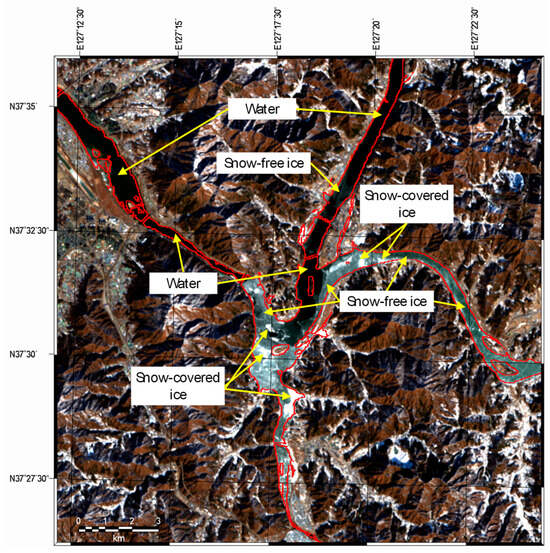
Figure 2.
An example of manual extraction of samples for snow-covered ice, snow-free ice, and water-based on visual investigation of the Landsat-8 RGB true color composite image at the path/row 116/34, obtained on 1 January 2018. The image area corresponds to the yellow box on the right image in Figure 1, and the red lines indicate the water boundary.
The relative standard deviation of mean OZ concentrations over the Han River for the used Landsat-8 data (0.10) was smaller than that of AOD (0.64) and WV content (0.26). The samples corresponding to 15 and 24 February 2017 and 28 January 2022, under different conditions of AOD and WV content (Table 1), were used as the test dataset (5390 samples per class), while the remaining samples (20,410 samples per class) were used to train the river ice mapping model.
3.2. Evaluation of the River Ice Mapping Models
The performance of the RF model can be improved by tuning hyperparameters [72]. The number of trees to grow (ntree) and the number of variables to split at each node (mtry) are the key parameters to optimize in the RF model [73,74,75,76]. To determine the optimal combination of ntree and mtry for each variable selection scheme, we utilized a grid search approach where ntree was increased from 100 to 3000 in steps of 100, and mtry was increased from 1 to half of the number of input variables. During the hyperparmeterization process, the classification performance of the river ice mapping model was evaluated based on 5-fold cross-validation. Typical accuracy evaluation metrics for the classification task, including user’s accuracy, producer’s accuracy, overall accuracy, and kappa coefficient, were used to validate the trained river ice mapping model.
The RF model for each variable selection scheme, trained by implementing the optimal combination of ntree and mtry, was applied to the test dataset, and its performance was assessed based on the accuracy evaluation metrics. The samples used for the RF model development were manually extracted as the representative pixels showing the spectral characteristics of each class. This might overestimate the accuracy metrics. Therefore, the river ice mapping results need to be evaluated using reference maps. However, as mentioned above, there are no reference data for the ice on the Han River.
In this study, we generated reference river ice maps by manual interpretation and digitizing the Landsat-8 RGB true-color composite images used as the test dataset and compared them with the river ice mapping result from the RF model based on each variable selection scheme. Then, the accuracy evaluation metrics based on the manually generated reference maps were calculated. This evaluation was intensively conducted for the region around Lake Paldang and its upper and lower reaches, indicated by a yellow rectangle in the right image of Figure 1. This region is the confluence of the multiple river streams of various flow rates and water turbidity, captured in the Landsat-8 path/row of both 115/34 and 116/34. The region is suitable for testing the river ice mapping model performance because it freezes every year, unlike elsewhere in the Han River system, and forms snow-free and snow-covered ice with different extents and thicknesses. Consequently, the best RF model for river ice mapping was determined, and the variable importance of the model was analyzed.
The reference river ice maps generated through manual interpretation and digitization of Landsat-8 RGB true-color composite images may contain uncertainties. The accuracy of these maps can be significantly influenced by the subjectivity of the analyst in determining boundaries between ice and water and differentiating between ice types. However, in the Landsat-8 RGB true-color composite images, the boundaries between water and ice were visually clear, and snow-free ice and snow-covered ice were distinguishable due to differences in reflectance within the visible spectrum. Additionally, a single analyst generated the reference ice maps in this study, ensuring consistency in the manual interpretation. Despite this, uncertainties may still arise due to the 30 m spatial resolution of Landsat-8 OLI images, which may be insufficient to detect small ice fragments and could result in mixed pixels containing different ice types, water, and land. These factors could lead to inaccuracies in evaluating the performance of the developed river ice mapping models. While clouds and shadows are potential obstacles in the manual interpretation of optical imagery, neither were present in the areas used to generate the reference ice maps.
The accuracy of the reference ice maps generated by the manual interpretation of Landsat-8 images can be assessed using higher-resolution imagery [25]. In this study, the accuracy of a reference ice map was evaluated by manually identifying and mapping river ice from a Sentinel-2 Level-1C RGB true-color composite image with a 10 m spatial resolution, acquired by the satellite’s Multi-Spectral Instrument (MSI). No Sentinel-2 images were available for the exact dates of the three reference ice maps for the Landsat-8 images used as the test dataset. However, Sentinel-2 images on 12 February 2017 (3 days prior to the Landsat-8 reference river ice map on 15 February 2017) and 27 January 2022 (1 day prior to the Landsat-8 reference river ice map on 28 January 2022) were available. The image from 27 January 2022 could not be used due to cloud cover over the test area (around Paldang Lake). Consequently, the Sentinel-2 image on 12 February 2017 was used to manually generate a river ice map, which was then compared with the Landsast-8 reference river ice map from 3 days later. Although the Sentinel-2 river ice map was also generated through manual interpretation, its higher spatial resolution allowed for a more precise delineation of ice and water. Therefore, it serves as a valuable tool for evaluating the accuracy of the Landsat-8 reference river ice map. While there may be slight changes in ice distribution over the 3-day interval, the Sentinel-2 image was captured at nearly the same time as the Landsat-8 image (02:18 UTC for Sentinel-2 and 02:10 UTC for Landsat-8), ensuring similar solar altitude and azimuth conditions. This allows for a reliable comparison between the two river ice maps generated through manual interpretation. To calculate the accuracy evaluation metrics of the Landsat-8 reference river ice map through comparison with the Sentienl-2 river ice map, the Landsat-8 river ice map was resampled to a grid size of 10 m using nearest neighbor interpolation.
4. Results
4.1. Performance of River Ice Mapping Models Evaluated Based on Test Samples
The most optimal hyperparameters (ntree and mtry) for each variable selection scheme are provided in Table 2. The tuned model for all schemes showed very high overall accuracy and kappa coefficient (higher than 98% and 0.98, respectively) for the classification of water, snow-covered ice, and snow-free ice from the test dataset. However, the test performances varied depending on the variable selection schemes and atmospheric conditions.
Under low AOD (0.08) and medium WV content (0.31 g/cm2) conditions (28 January 2022), the river ice mapping models for variable selection schemes 1, 2, 5, and 6 showed excellent performance (Figure 3a). In contrast, the river ice mapping models for schemes 3 and 4 exhibited high commission error for water and high omission error for snow-free ice, despite the inclusion of atmospheric factors as input variables.
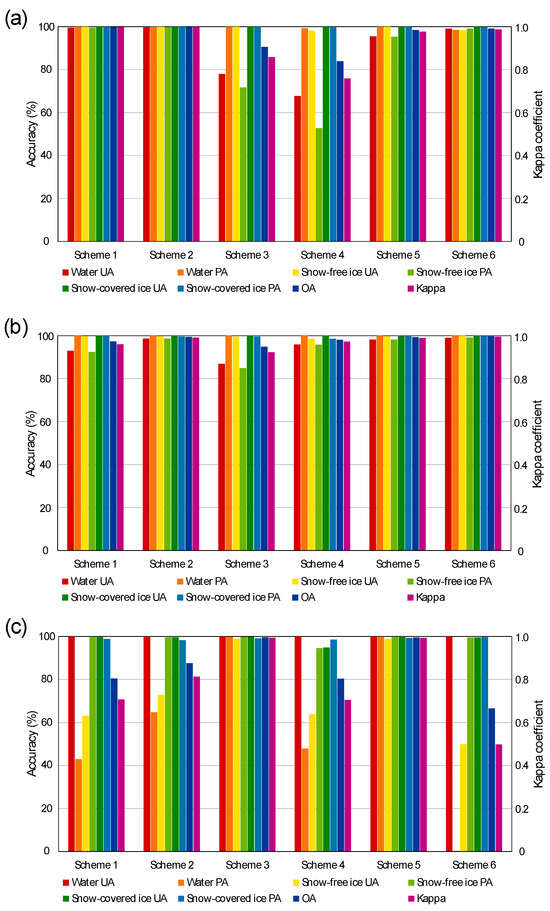
Figure 3.
Accuracy evaluation metrics of the RF-based river ice mapping model developed using different variable selection schemes for the test samples from the Landast-8 OLI dataset on (a) 28 January 2022 (medium WV and low AOD), (b) 24 February 2017 (high WV and low ADO), and (c) 15 February 2017 (high WV and high AOD).
The river ice mapping models developed based on the different variable selection schemes, except for scheme 3, showed excellent performance under the atmospheric condition of high WV content (0.45 g/cm2) and low AOD (0.08) on 24 February 2017 (Figure 3b). The model for scheme 3 also showed high overall accuracy (94.85%) and kappa coefficient (0.92) but had a 10% higher omission error for snow-free ice and commission error for water compared to the models based on other schemes. Under the atmospheric condition of both high WV content (0.52 g/cm2) and high AOD (0.31) on 15 February 2017, only the river ice mapping models for variable selection schemes 3 and 5 showed great performance (Figure 3c). The models for the other schemes introduced large omission errors for water and commission errors for snow-free ice. The model developed for scheme 6, which utilized the atmospherically corrected multispectral surface reflectance provided by the USGS, showed the worst performance. This suggests that the accuracy of the atmospheric correction for water and ice in the operationally distributed Landsat-8 surface reflectance data may be insufficient for river ice mapping under atmospheric conditions heavily contaminated by aerosol and water vapor.
Based on the performance evaluation in different atmospheric conditions using the test samples, the RF-based river ice mapping model developed using variable selection scheme 5, which includes multispectral TOA reflectance, NDSI, NDWI, NDBI, and atmospheric factors as input variables, showed the best performance in river ice mapping of the Han River. However, as mentioned above, the accuracy evaluation metrics shown in Figure 3 may be overrated because the samples used for model development and testing were pixels showing representative spectral characteristics for each class. For a more dependable evaluation of model performance, the accuracy metrics were calculated based on river ice maps for a test region (the yellow box in the right image of Figure 1) generated by manual interpretation of Landsat-8 OLI RGB true-color composite images.
4.2. Performance of River Ice Mapping Models Evaluated Based on Manually Interpreted Maps for Test Site
The Landsat-8 OLI true-color composite images on 28 January 2022, under medium WV content and low AOD conditions, and the corresponding river ice maps generated by manual interpretation and the RF model for each variable selection scheme for the region of Paldang Lake and surrounding river streams, are shown in Figure 4a–h. Figure 4i shows the accuracy evaluation metrics for the modeled maps retrieved from different variable selection schemes, calculated based on the reference map (Figure 4b). The river ice maps classified from schemes 1 and 5 (Figure 4c,g) closely matched the reference one (Figure 4b), demonstrating overall accuracy and kappa coefficient higher than 92% and 0.84, respectively (Figure 4h). The river ice mapping models based on the other schemes, except for scheme 6, misclassified many snow-free ice areas as water, particularly in Areas A and B in Figure 4a (Figure 4d–f). The scheme 6-based river ice mapping model, developed using atmospherically corrected multispectral surface reflectance, misclassified a significant portion of snow-free ice as snow-covered ice in Area D. The river ice map classified using indices and atmospheric parameters (scheme 4, Figure 4f) exhibited the largest errors in detecting snow-covered ice (Area D) and snow-free ice (Areas A–C).
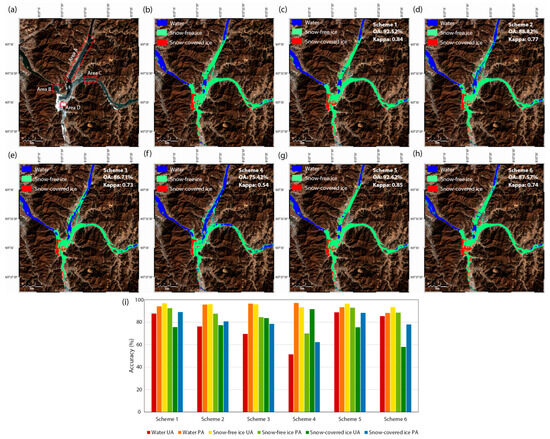
Figure 4.
(a) Landsat-8 OLI RGB true-color composite image on 28 January 2022 (low AOD conditions, medium WV content) and the corresponding river ice map generated by (b) manual interpretation and (c–h) the RF models based on variable selection schemes 1 to 6 around the Paldang Lake. (i) Accuracy assessment metrics of the RF model-derived river ice maps calculated based on (b).
For the case of 24 February 2017 (Figure 5a), when WV content was high and AOD was low, the river ice mapping models developed based on all variable selection schemes showed good performance in detecting water and snow-free river ice (Figure 5c–h), with overall accuracy and kappa coefficient higher than 89% and 0.77, respectively, when compared to the reference river ice map (Figure 5b). However, the river ice mapping models, except for schemes 5 and 6, misclassified some pixels of snow-free ice as water, especially in Area A indicated in Figure 5a. Additionally, the models developed for schemes 1–4 and 6 did not detect snow-covered ice well (Area B), although there was little snow-covered ice in the test region. In contrast, the model for scheme 5 showed high performance in detecting snow-covered ice as well (Figure 5g), and achieving the greatest overall accuracy (94.1%) and kappa coefficient (0.88) (Figure 5i).
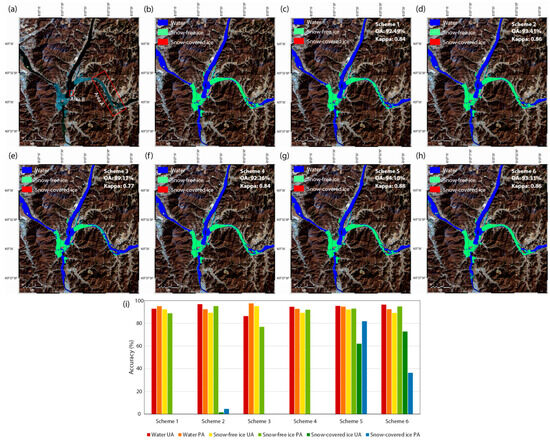
Figure 5.
(a) Landsat-8 OLI RGB true-color composite image on 24 February 2017 (low AOD conditions, high WV content) and the corresponding river ice map generated by (b) manual interpretation and (c–h) the RF models based on variable selection schemes 1 to 6 around the Paldang Lake. (i) Accuracy assessment metrics of the RF model-derived river ice maps calculated based on (b).
The Landsat-8 true-color composite image on 15 February 2017, under high AOD and WV content conditions, showed that ice appeared very bright despite adjustments to the RGB color contrast (Figure 6a). This brightness is primarily attributed to the high AOD. Compared to the manually interpreted reference map (Figure 6b), the river ice mapping models based on variable selection schemes 1, 2, 4, and 6 misclassified most water as snow-free ice in Areas A, B, and C (Figure 6b,c,e,h). Moreover, these models tended to classify snow-covered ice as snow-free ice, leading to low overall accuracy and kappa coefficient. The river ice map generated from the RF models based on schemes 3 and 5 demonstrated superior and similar performance (Figure 6i), with overall accuracy and kappa coefficient higher than 82% and 0.74, respectively.
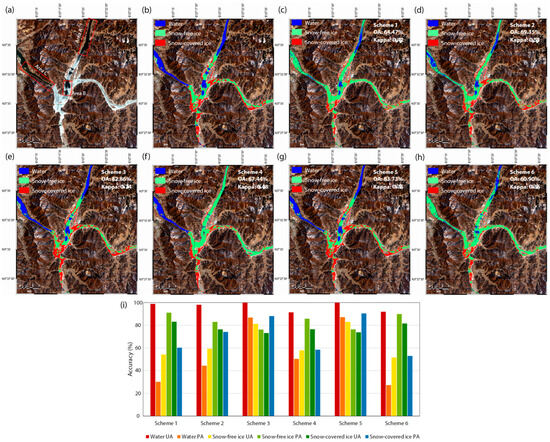
Figure 6.
(a) Landsat-8 OLI RGB true-color composite image on 15 February 2017 (high AOD conditions, high WV content) and the corresponding river ice map generated by (b) manual interpretation and (c–h) the RF models based on variable selection schemes 1 to 6 around the Paldang Lake. (i) Accuracy assessment metrics of the RF model-derived river ice maps calculated based on (b).
Based on the performance evaluation in different atmospheric conditions using the test samples and reference maps, the RF model developed using variable selection scheme 5, which includes multispectral TOA reflectance, NDSI, NDWI, NDBI, and atmospheric factors as input variables, was determined to be the best for river ice mapping of the Han River. Figure 7, Figure 8 and Figure 9 show the Landsat-8 OLI RGB true-color composite images used for the extraction of test samples and the corresponding river ice maps retrieved from the RF model implementing variable selection scheme 5. From Figure 7, Figure 8 and Figure 9, it can be observed that river ice mapping performed well regardless of the atmospheric conditions for the Han River. Notably, the RF-based river ice mapping model proposed in this study effectively classified turbid water with relatively high multispectral reflectance as water, not as ice. In some cases, ice was mapped at the edges of streams, not because the water was misclassified as ice, but because the water level in the stream was below the normal level, and the land was included in the polygons used to define the Han River area, resulting in that portion being classified as ice.
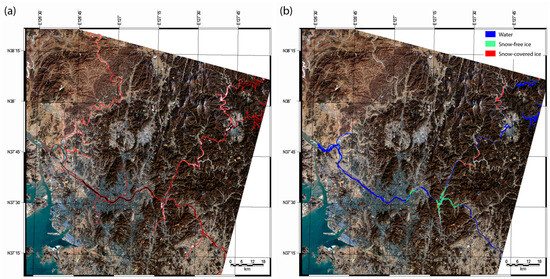
Figure 7.
(a) Landsat-8 OLI RGB true-color composite image on 28 January 2022 and (b) the corresponding river ice map generated by the RF model based on variable selection scheme 5. Red polygons in (a) represent the streams of the Han River.
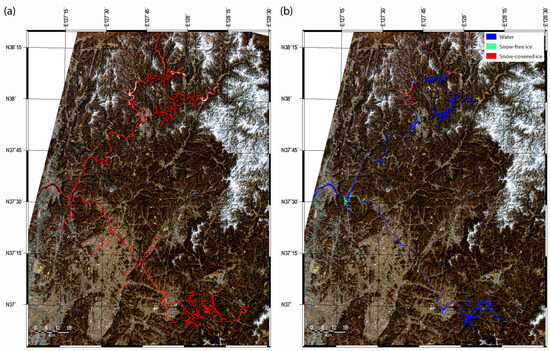
Figure 8.
(a) Landsat-8 OLI RGB true-color composite image on 24 February 2017 and (b) the corresponding river ice map generated by the RF model based on variable selection scheme 5. The red polygons in (a) represent the streams of the Han River.
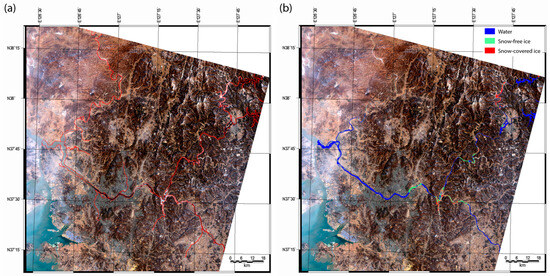
Figure 9.
(a) Landsat-8 OLI RGB true-color composite image on 15 February 2017 and (b) the corresponding river ice map generated by the RF model based on variable selection scheme 5. The red polygons in (a) represent the streams of the Han River.
5. Discussion
The river ice mapping models based on the RF implementing different variable selection schemes were developed and evaluated for different atmospheric conditions. However, the performance evaluation of these models may be subject to potential uncertainties due to the inaccuracy of the reference ice maps generated through the manual interpretation of Landsat-8 RGB true-color composite images. To assess the accuracy of the Landsat-8 reference river ice map, it was compared with a river ice map generated from the manual interpretation of a higher-resolution Sentinel-2 RGB true-color composite image. Figure 10 shows the Sentinel-2 RGB true-color composite image on 12 February 2017, along with the corresponding river ice map for the test site at Paldang Lake and surrounding streams. In the Sentinel-2 RGB true-color composite image (Figure 10a), the boundaries between snow-free ice and snow-covered ice were more clearly defined compared to the Landsat-8 RGB-true-color composite image on 15 February 2017 (Figure 6a) due to the higher spatial resolution. The distribution of water in the river ice maps generated from both Landsat-8 (Figure 6b) and Sentinel-2 (Figure 10b) appeared highly similar, with producer’s and user’s accuracies for water in the Landsat-8 reference river ice map exceeding 95% (Table 3).
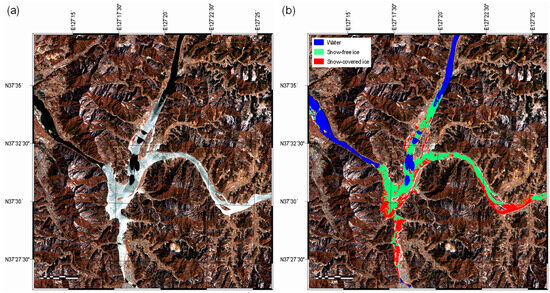
Figure 10.
(a) Sentinel-2 MSI RGB true-color composite image on 12 February 2017 around the Paldang Lake and (b) the corresponding river ice map generated by manual interpretation.

Table 3.
Accuracy assessment metrics for the river ice map generated from the manual interpretation of the Landsat-8 RGB true-color composite image on 15 February 2017, calculated using the Sentinel-2 river ice map on 12 February 2017, as the reference data.
The snow-covered ice and snow-free ice in the Landsat-8 reference river ice map exhibited relatively lower producer’s and user’s accuracies, ranging from 80% to 86% (Table 3). This may be attributed to the lower spatial resolution of the Landsat-8 OLI compared to Sentinel-2 MSI, as well as potential effects from snow cover changes, ice melting, or refreezing that could have occurred during the 3-day interval between the acquisition times of the two satellite images. Nevertheless, the distribution of the two types of river ice and water in the Landsat-8 reference river ice map (Figure 6b) closely matched that of the Sentinel-2-based map (Figure 10b), with an overall accuracy of 87.0% and a kappa coefficient of 0.80 (Table 3). These results suggest that the reference river ice map generated from the manual interpretation of Landsat-8 RGB true-color composite images can be reliably used to evaluate the performance of river ice mapping models.
Under low AOD and WV content, the RF model developed based solely on multispectral TOA reflectance showed good performance for mapping river ice, despite not considering atmospheric factors as input variables. However, its performance declined when the TOA multispectral reflectance was contaminated by atmospheric influence, especially under high AOD. Meanwhile, the RF model based on variable selection scheme 5, which uses TOA multispectral reflectance, indices, and atmospheric factors as input variables, was assessed as the best model for river ice mapping regardless of atmospheric conditions at the time of Landsat-8 image acquisition.
The relative importance of variables for the best river ice mapping model, i.e., the RF model developed using variable selection scheme 5, is shown in Figure 11. AOD was identified as the most important variable, with WV content and OZ concentration being the second and third most important. NDWI was the fourth important variable, contributing to the separation of water from ice. Surface elevation was the next important variable, demonstrating its relevance to the atmospheric path length. The next important variables were followed by NDSI, NDBI, and TOA reflectance in near-infrared and visible wavelengths. This result indicates that atmospheric factors are crucial for river ice mapping from atmospherically uncorrected optical remote sensing data, and they can be effectively incorporated through machine learning approaches.
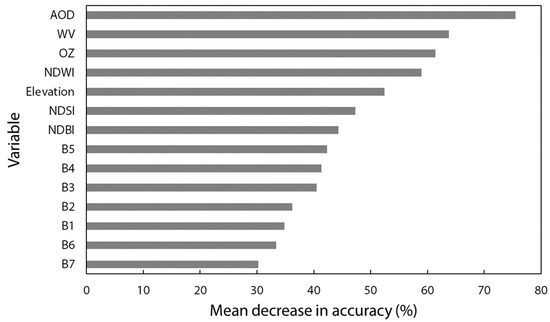
Figure 11.
Mean decrease in accuracy of the RF-based river ice mapping model using the input variable selection scheme 5.
The RF-based river ice mapping model implementing variable selection scheme 5 is expected to be very effective in regions with heterogeneous snow cover on river ice and various aerosol and water vapor content conditions. Furthermore, the developed river ice mapping model can be applied to Landsat-9 OLI-2 data. The radiometric resolution of Landsat-9 OLI-2 multispectral data is 14-bit, which is higher than that of Landsat-8 OLI data (12-bit). However, the multispectral reflectance and spectral indices of the two instruments show high consistency, with differences of approximately 2% [77,78,79]. Consequently, the river ice mapping can be conducted at an 8-day interval by combining Landsat-8 OLI and Landsat-9 OLI-2 multispectral data [80].
The feasibility of the river ice mapping model could be highly dependent on cloud distribution because multispectral observations of rivers cannot be conducted under clouds. The atmospheric factors, the most important variables in the river ice mapping model, were derived from MODIS products, which are unavailable for cloudy areas. Therefore, the river ice mapping model proposed in this study could not be applied when MODIS-derived atmospheric factors are unavailable, even if the river regions are observed in Landsat-8 data. Additionally, the MODIS mission is nearing its end. Although the various scientific products provided by MODIS can be replaced by those based on the Visible Infrared Imaging Radiometer Suite (VIIRS)-based products [81], the change in input data for the river ice mapping model will necessitate the redevelopment. Furthermore, the temporal resolution of Landsat-8 is 16 days, which would not be sufficient for monitoring river ice that experiences dramatic changes in extent, snow cover characteristics, and thickness [21,22]. The river ice mapping cycle can be shortened to 8 days by combining Landsat-9 data. However, an even shorter mapping cycle is required for rapidly changing river ice, necessitating the development of a river ice mapping model for multi-sensor observations, including SAR.
Accurate river ice mapping also requires a precise definition of river areas. If the river areas are not accurately defined, especially if the land is defined as part of the river, incorrect river ice mapping results showing ice where none exists could be derived from the RF-based model proposed in this study. While a method can be used to define the river area using appropriate thresholds from NDWI, accurate area definition can be challenging if the land around the river is covered with snow. Therefore, a more accurate method of defining the river area needs to be developed before river ice mapping.
6. Conclusions
River ice mapping models for the Landsat-8 OLI atmospherically uncorrected multispectral data over the Han River in South Korea were developed using a Random Forest (RF)-based classification approach. The RF model, which utilized TOA multispectral reflectance, NDSI, NDWI, NDBI, and atmospheric factors derived from MODIS and GLO-30 DEM as input variables, demonstrated the best performance in mapping snow-covered ice, snow-free ice, and water under varying atmospheric conditions. This model outperformed those based on other variable combinations. The analysis identified aerosol optical depth (AOD) and water vapor (WV) content as the most influential variables, highlighting their significant impact on the accuracy of river ice mapping. The inclusion of these atmospheric factors, along with the spectral indices, enabled the RF model to effectively handle atmospheric disturbances and improve classification accuracy. This study underscores the potential of using atmospherically contaminated multispectral TOA reflectance data for monitoring river ice when complemented with atmospheric auxiliary data through machine learning approaches. The results suggest that even without atmospheric correction, multispectral TOA reflectance data can provide valuable insights into river ice dynamics, provided that appropriate machine learning techniques and atmospheric data are applied to mitigate atmospheric effects.
Future research should explore the integration of additional remote sensing technologies, such as SAR, to further enhance the temporal resolution and accuracy of river ice mapping. Additionally, developing more advanced methods for accurately defining river boundaries, especially in areas with significant snow cover, will be crucial for improving the reliability of river ice maps.
Author Contributions
Conceptualization, H.H.; methodology, H.H.; software, H.H.; validation, H.H.; formal analysis, H.H., T.K. and S.K.; investigation, H.H., T.K. and S.K.; resources, H.H.; data curation, H.H.; writing—original draft preparation, H.H.; writing—review and editing, H.H.; visualization, H.H.; funding acquisition, H.H. All authors have read and agreed to the published version of the manuscript.
Funding
This study was funded by a 2022 Research Grant from Kangwon National University and the Basic Science Research Program through the National Research Foundation of Korea (NRF) funded by the Ministry of Education (No. 2019R1A6A1A03033167).
Data Availability Statement
The Landsat-8 OLI data can be downloaded from the United States Geological Survey (USGS)’s data search website (EarthExplorer) at https://earthexplorer.usgs.gov/ (accessed on 12 July 2024). The MOD09 products can be downloaded from the National Aeronautics and Space Administration (NASA)’s Level-1 and Atmosphere Archive & Distribution System Distributed Active Archive Center at https://ladsweb.modaps.eosdis.nasa.gov/ (accessed on 12 July 2024). The Copernicus GLO-30 DEM can be downloaded from the OpenTopography website at https://portal.opentopography.org/raster?opentopoID=OTSDEM.032021.4326.3 (accessed on 12 July 2024).
Acknowledgments
The author would like to thank the United States Geological Survey (USGS) for providing Landsat-8 data.
Conflicts of Interest
The authors declare no conflicts of interest.
References
- Beltaos, S.; Prowse, T. River-ice hydrology in a shrinking cryosphere. Hydrol. Process. 2009, 23, 122–144. [Google Scholar] [CrossRef]
- Prowse, T.D. River-ice ecology. I: Hydrologic, geomorphic, and water-quality aspects. J. Cold Reg. Eng. 2001, 15, 1–16. [Google Scholar] [CrossRef]
- Prowse, T.D.; Beltaos, S. Climatic control of river-ice hydrology: A review. Hydrol. Process. 2002, 16, 805–822. [Google Scholar] [CrossRef]
- Rokaya, P.; Budhathoki, S.; Lindenschmidt, K.E. Trends in the timing and magnitude of ice-jam floods in Canada. Sci. Rep. 2018, 8, 5834. [Google Scholar] [CrossRef]
- Thellman, A.; Jankowski, K.J.; Hayden, B.; Yang, X.; Dolan, W.; Smits, A.P.; O’Sullivan, A.M. The ecology of river ice. J. Geophys. Res. Biogeosci. 2021, 126, e2021JG006275. [Google Scholar] [CrossRef]
- Beltaos, S. Progress in the study and management of river ice jams. Cold Reg. Sci. Tech. 2008, 51, 2–19. [Google Scholar] [CrossRef]
- Das, A.; Rokaya, P.; Lindenschmidt, K.E. Ice-jam flood risk assessment and hazard mapping under future climate. J. Water Resour. Plan. Manag. 2020, 146, 04020029. [Google Scholar] [CrossRef]
- Lindenschmidt, K.-E.; Das, A.; Rokaya, P.; Chu, T. Ice-jam flood risk assessment and mapping. Hydrol. Process. 2016, 30, 3754–3769. [Google Scholar] [CrossRef]
- Lesack, L.F.W.; Marsh, P.; Hicks, F.E.; Forbes, D.L. Local spring warming drives earlier river-ice breakup in a large Arctic delta. Geophys. Res. Lett. 2014, 41, 1560–1566. [Google Scholar] [CrossRef]
- Chen, Y.; She, Y. Long-term variations of river ice breakup timing across Canada and its response to climate change. Cold Reg. Sci. Tech. 2020, 176, 103091. [Google Scholar] [CrossRef]
- Oh, S.-B.; Byun, H.-R. Long-term variation of the freezing climate near the Han River and Seoul in Korea. J. Kor. Earth Sci. Soc. 2011, 32, 761–769. [Google Scholar] [CrossRef][Green Version]
- de Roda Husman, S.; van der Sanden, J.J.; Lhermitte, S.; Eleveld, M.A. Integrating intensity and context for improved supervised river ice classification from dual-pol Sentinel-1 SAR data. Int. J. Appl. Earth Obs. Geoinf. 2021, 101, 102359. [Google Scholar] [CrossRef]
- Engram, M.; Meyer, F.J.; Brown, D.R.N.; Clement, S.; Bondurant, A.C.; Spellman, K.V.; Oxtoby, L.E.; Arp, C.D. Detecting early winter open-water zones on Alaska rivers using dual-polarized C-band Sentinel-1 synthetic aperture radar (SAR). Remote Sens. Environ. 2024, 305, 114096. [Google Scholar] [CrossRef]
- Mermoz, S.; Allain, S.; Bernier, M.; Pottier, E.; Gherboudj, I. Classification of river ice using polarimetric SAR data. Can. J. Remote Sens. 2009, 35, 460–473. [Google Scholar] [CrossRef]
- Sobiech, J.; Dierking, W. Observing lake- and river-ice decay with SAR: Advantages and limitations of the unsupervised k-means classification approach. Ann. Glaciol. 2013, 54, 65–72. [Google Scholar] [CrossRef]
- Stonevicius, E.; Uselis, G.; Grendaite, D. Ice Detection with Sentinel-1 SAR backscatter threshold in long sections of temperate climate rivers. Remote Sens. 2022, 14, 1627. [Google Scholar] [CrossRef]
- Mermoz, S.; Allain-Bailhache, S.; Bernier, M.; Pottier, E.; Van Der Sanden, J.J.; Chokmani, K. Retrieval of river ice thickness from C-Band PolSAR data. IEEE Trans. Geosci. Remote Sens. 2014, 52, 3052–3062. [Google Scholar] [CrossRef]
- Barbieux, K.; Charitsi, A.; Merminod, B. Icy lakes extraction and water-ice classification using Landsat 8 OLI multispectral data. Int. J. Remote Sens. 2018, 39, 3646–3678. [Google Scholar] [CrossRef]
- Gatto, L.W. Monitoring river ice with Landsat images. Remote Sens. Environ. 1990, 32, 1–16. [Google Scholar] [CrossRef]
- Li, H.; Li, H.; Wang, J.; Hao, X. Monitoring high-altitude river ice distribution at the basin scale in the northeastern Tibetan Plateau from a Landsat time-series spanning 1999–2018. Remote Sens. Environ. 2020, 247, 111915. [Google Scholar] [CrossRef]
- Li, H.; Li, H.; Wang, J.; Hao, X. Identifying river ice on the Tibetan Plateau based on the relative difference in spectral bands. J. Hydrol. 2021, 601, 126613. [Google Scholar] [CrossRef]
- Li, H.; Li, H.; Wang, J.; Hao, X. Revealing the river ice phenology on the Tibetan Plateau using Sentinel-2 and Landsat 8 overlapping orbit imagery. J. Hydrol. 2023, 619, 129285. [Google Scholar] [CrossRef]
- Yang, X.; Pavelsky, T.M.; Allen, G.H. The past and future of global river ice. Nature 2020, 577, 69–73. [Google Scholar] [CrossRef] [PubMed]
- Kääb, A.; Altena, B.; Mascaro, J. River-ice and water velocities using the Planet optical cubesat constellation. Hydrol. Earth Syst. Sci. 2019, 23, 4233–4247. [Google Scholar] [CrossRef]
- Zakharov, I.; Puestow, T.; Khan, A.A.; Briggs, R.; Barrette, P. Review of River Ice Observation and Data Analysis Technologies. Hydrology 2024, 11, 126. [Google Scholar] [CrossRef]
- Chaouch, N.; Temimi, M.; Romanov, P.; Cabrera, R.; McKillop, G.; Khanbilvardi, R. An automated algorithm for river ice monitoring over the Susquehanna River using the MODIS data. Hydrol. Process. 2014, 28, 62–73. [Google Scholar] [CrossRef]
- Cooley, S.W.; Pavelsky, T.M. Spatial and temporal patterns in Arctic river ice breakup revealed by automated ice detection from MODIS imagery. Remote Sens. Environ. 2016, 175, 310–322. [Google Scholar] [CrossRef]
- Beaton, A.; Whaley, R.; Corston, K.; Kenny, F. Identifying historic river ice breakup timing using MODIS and Google Earth Engine in support of operational flood monitoring in Northern Ontario. Remote Sens. Environ. 2019, 224, 352–364. [Google Scholar] [CrossRef]
- Temimi, M.; Abdelkader, M.; Tounsi, A.; Chaouch, N.; Carter, S.; Sjoberg, B.; Macneil, A.; Bingham-Maas, N. An Automated System to Monitor River Ice Conditions Using Visible Infrared Imaging Radiometer Suite Imagery. Remote Sens. 2023, 15, 4896. [Google Scholar] [CrossRef]
- Kraatz, S.; Khanbilvardi, R.; Romanov, P. A Comparison of MODIS/VIIRS Cloud Masks over Ice-Bearing River: On Achieving Consistent Cloud Masking and Improved River Ice Mapping. Remote Sens. 2017, 9, 229. [Google Scholar] [CrossRef]
- Kraatz, S.; Khanbilvardi, R.; Romanov, P. River ice monitoring with MODIS: Application over Lower Susquehanna River. Cold Reg. Sci. Tech. 2016, 131, 116–128. [Google Scholar] [CrossRef]
- Griffina, C.G.; McClelland, J.W.; Frey, K.E.; Fiske, G.; Holmes, R.M. Quantifying CDOM and DOC in major Arctic rivers during ice-free conditions using Landsat TM and ETM+ data. Remote Sens. Environ. 2018, 209, 395–409. [Google Scholar] [CrossRef]
- Heinilä, K.; Mattila, O.-P.; Metsämäki, S.; Väkevä, S.; Luojus, K.; Schwaizer, G.; Koponen, S. A novel method for detecting lake ice cover using optical satellite data. Int. J. Appl. Earth Obs. Geoinf. 2021, 104, 102566. [Google Scholar] [CrossRef]
- Vermote, E.; Justice, C.; Claverie, M.; Franch, B. Preliminary analysis of the performance of the Landsat 8/OLI land surface reflectance product. Remote Sens. Environ. 2016, 185, 46–56. [Google Scholar] [CrossRef]
- Gascon, F.; Bouzinac, C.; Thépaut, O.; Jung, M.; Francesconi, B.; Louis, J.; Lonjou, V.; Lafrance, B.; Massera, S.; Gaudel-Vacaresse, A.; et al. Copernicus Sentinel-2A calibration and products validation status. Remote Sens. 2017, 9, 584. [Google Scholar] [CrossRef]
- Sola, I.; García-Martín, A.; Sandonís-Pozo, L.; Álvarez-Mozos, J.; Pérez-Cabello, F.; González-Audícana, M.; Llovería, R.M. Assessment of atmospheric correction methods for Sentinel-2 images in Mediterranean landscapes. Int. J. Appl. Earth Obs. Geoinf. 2018, 73, 63–76. [Google Scholar] [CrossRef]
- Sayler, K. Landsat 8-9 Collection 2 Level 2 Science Product Guide. Version 6.0. 2024. Available online: https://www.usgs.gov/media/files/landsat-8-9-collection-2-level-2-science-product-guide (accessed on 12 July 2024).
- Martins, V.S.; Barbosa, C.C.F.; De Carvalho, L.A.S.; Jorge, D.S.F.; Lobo, F.D.L.; Novo, E.M.L.d.M. Assessment of atmospheric correction methods for Sentinel-2 MSI images applied to Amazon floodplain lakes. Remote Sens. 2017, 9, 322. [Google Scholar] [CrossRef]
- Kim, D.; Won, Y.J.; Han, S.; Han, H. A Study on the retrieval of river turbidity based on KOMPSAT-3/3A images. Korean J. Remote Sens. 2022, 38, 1285–1300. [Google Scholar] [CrossRef]
- Loveland, T.R.; Irons, J.R. Landsat 8: The plans, the reality, and the legacy. Remote Sens. Environ. 2016, 185, 1–6. [Google Scholar] [CrossRef]
- NASA. Worldwide Reference System. Available online: https://landsat.gsfc.nasa.gov/about/the-worldwide-reference-system (accessed on 20 August 2024).
- Vermote, E.; Roger, J.C.; Franch, B.; Skakun, S. LaSRC (Land Surface Reflectance Code): Overview, Application and Validation Using MODIS, VIIRS, LANDSAT and Sentinel 2 Data’s. In Proceedings of the IGARSS 2018—2018 IEEE International Geoscience and Remote Sensing Symposium, Valencia, Spain, 22–27 July 2018; pp. 8173–8176. [Google Scholar] [CrossRef]
- Guanter, L.; Del Carmen González-Sanpedro, M.; Moreno, J. A method for the atmospheric correction of ENVISAT/MERIS data over land targets. Int. J. Remote Sens. 2007, 28, 709–728. [Google Scholar] [CrossRef]
- Jiménez-Muñoz, J.C.; Sobrino, J.A.; Mattar, C.; Franch, B. Atmospheric correction of optical imagery from MODIS and Reanalysis atmospheric products. Remote Sens. Environ. 2010, 114, 2195–2210. [Google Scholar] [CrossRef]
- Vanhellemont, Q.; Ruddick, K. Atmospheric correction of metre-scale optical satellite data for inland and coastal water applications. Remote Sens. Environ. 2018, 216, 586–597. [Google Scholar] [CrossRef]
- Béal, D.; Baret, F.; Bacour, C.; Gu, X.-F. A method for aerosol correction from the spectral variation in the visible and near infrared: Application to the MERIS sensor. Int. J. Remote Sens. 2007, 28, 761–779. [Google Scholar] [CrossRef]
- Richter, R.; Schläpfer, D.; Müller, A. An automatic atmospheric correction algorithm for visible/NIR imagery. Int. J. Remote Sens. 2006, 27, 2077–2085. [Google Scholar] [CrossRef]
- Wang, M. Extrapolation of the aerosol reflectance from the near-infrared to the visible: The single-scattering epsilon vs multiple-scattering epsilon method. Int. J. Remote Sens. 2004, 25, 3637–3650. [Google Scholar] [CrossRef]
- Waquet, F.; Péré, J.-C.; Peers, F.; Goloub, P.; Ducos, F.; Thieuleux, F.; Tanré, D. Global detection of absorbing aerosols over the ocean in the red and near-infrared spectral region. J. Geophys. Res. Atmos. 2016, 121, 10902–10918. [Google Scholar] [CrossRef]
- Orphal, J.; Staehelin, J.; Tamminen, J.; Braathen, G.; De Backer, M.-R.; Bais, A.; Balis, D.; Barbe, A.; Bhartia, P.K.; Birk, M.; et al. Absorption cross-sections of ozone in the ultraviolet and visible spectral regions: Status report 2015. J. Mol. Spectrosc. 2016, 327, 105–121. [Google Scholar] [CrossRef]
- Pei, L.; Min, Q.; Du, Y.; Wang, Z.; Yin, B.; Yang, K.; Disterhoft, P.; Pongetti, T.; Zhu, L. Water vapor near-UV absorption: Laboratory spectrum, field evidence, and atmospheric impacts. J. Geophys. Res. Atmos. 2019, 124, 14310–14324. [Google Scholar] [CrossRef]
- Van Laake, P.E.; Sanchez-Azofeifa, G.A. Simplified atmospheric radiative transfer modelling for estimating incident PAR using MODIS atmosphere products. Remote Sens. Environ. 2004, 91, 98–113. [Google Scholar] [CrossRef]
- Wie, J.; Moon, B.-K. Seasonal relationship between meteorological conditions and surface ozone in Korea based on an offline chemistry–climate model. Atmos. Pollut. Res. 2016, 7, 385–392. [Google Scholar] [CrossRef]
- Bernardo, N.; Watanabe, F.; Rodrigues, T.; Alcântara, E. Atmospheric correction issues for retrieving total suspended matter concentrations in inland waters using OLI/Landsat-8 image. Adv. Space Res. 2017, 59, 2335–2348. [Google Scholar] [CrossRef]
- Breiman, L. Random forest. Mach. Learn. 2001, 45, 5–32. [Google Scholar] [CrossRef]
- Festa, D.; Casagli, N.; Casu, F.; Confuorto, P.; De Luca, C.; Del Soldato, M.; Lanari, R.; Manunta, M.; Manzo, M.; Raspini, F. Automated classification of A-DInSAR-based ground deformation by using random forest. GISci. Remote Sens. 2022, 59, 1749–1766. [Google Scholar] [CrossRef]
- Han, H.; Im, J.; Kim, M.; Sim, S.; Kim, J.; Kim, D.-j.; Kang, S.-H. Retrieval of melt ponds on Arctic multiyear sea ice in summer from TerraSAR-X dual-polarization data using machine learning approaches: A case study in the Chukchi Sea with mid-incidence angle data. Remote Sens. 2016, 8, 57. [Google Scholar] [CrossRef]
- Han, H.; Hong, S.-H.; Kim, H.-c.; Chae, T.-B.; Choi, H.-J. A study of the feasibility of using KOMPSAT-5 SAR data to map sea ice in the Chukchi Sea in late summer. Remote Sens. Lett. 2017, 8, 468–477. [Google Scholar] [CrossRef]
- Han, H.; Lee, S.; Kim, H.-C.; Kim, M. Retrieval of summer sea ice concentration in the Pacific Arctic Ocean from AMSR2 observations and numerical weather data using random forest regression. Remote Sens. 2021, 13, 2283. [Google Scholar] [CrossRef]
- Kim, M.; Kim, H.-C.; Im, J.; Lee, S.; Han, H. Object-based landfast sea ice detection over West Antarctica using time series ALOS PALSAR data. Remote Sens. Environ. 2020, 242, 111782. [Google Scholar] [CrossRef]
- Kollert, A.; Mayr, A.; Dullinger, S.; Hülber, K.; Moser, D.; Lhermitte, S.; Gascoin, S.; Rutzinger, M. Downscaling MODIS NDSI to Sentinel-2 fractional snow cover by random forest regression. Remote Sens. Lett. 2024, 15, 363–372. [Google Scholar] [CrossRef]
- Liang, T.; Sun, L.; Li, H. MODIS aerosol optical depth retrieval based on random forest approach. Remote Sens. Lett. 2020, 12, 179–189. [Google Scholar] [CrossRef]
- Wang, X.; Jiang, W.; Peng, K.; Li, Z.; Rao, P. A framework for fine classification of urban wetlands based on random forest and knowledge rules: Taking the wetland cities of Haikou and Yinchuan as examples. GISci. Remote Sens. 2022, 59, 2144–2163. [Google Scholar] [CrossRef]
- RColorBrewer, S.; Liaw, M.A. Package ‘Randomforest’; University of California: Berkeley, CA, USA, 2018. [Google Scholar]
- Ihlen, V. Landsat 8 (L8) Data Users Handbook. Version 5.0. 2019. Available online: https://www.usgs.gov/media/files/landsat-8-data-users-handbook (accessed on 12 July 2024).
- McFeeters, S.K. The use of the Normalized Difference Water Index (NDWI) in the delineation of open water features. Int. J. Remote Sens. 1996, 17, 1425–1432. [Google Scholar] [CrossRef]
- Hall, D.K.; Riggs, G.A.; Salomonson, V.V. Development of methods for mapping global snow cover using moderate resolution imaging spectroradiometer data. Remote Sens. Environ. 1995, 54, 127–140. [Google Scholar] [CrossRef]
- Kokhanovsky, A.; Lamare, M.; Danne, O.; Brockmann, C.; Dumont, M.; Picard, G.; Arnaud, L.; Favier, V.; Jourdain, B.; Le Meur, E.; et al. Retrieval of snow properties from the Sentinel-3 Ocean and Land Colour instrument. Remote Sens. 2019, 11, 2280. [Google Scholar] [CrossRef]
- Dastour, H.; Ghaderpour, E.; Hassan, Q.K. A combined approach for monitoring monthly surface water/ice dynamics of Lesser Slave Lake via earth observation data. IEEE J. Sel. Top. Appl. Earth Observ. Remote Sens. 2022, 15, 6402–6417. [Google Scholar] [CrossRef]
- Kneib, M.; Miles, E.S.; Jola, S.; Buri, P.; Herreid, S.; Bhattacharya, A.; Watson, C.S.; Bolch, T.; Quincey, D.; Pellicciotti, F. Mapping ice cliffs on debris-covered glaciers using multispectral satellite images. Remote Sens. Environ. 2021, 253, 112201. [Google Scholar] [CrossRef]
- Sojka, M.; Ptak, M.; Zhu, S. Use of Landsat satellite images in the assessment of the variability in ice cover on Polish lakes. Remote Sens. 2023, 15, 3030. [Google Scholar] [CrossRef]
- Probst, P.; Wright, M.N.; Boulesteix, A.-L. Hyperparameters and tuning strategies for random forest. Wiley Interdiscip. Rev. Data Mining Knowl. Discov. 2019, 9, e1301. [Google Scholar] [CrossRef]
- Dabija, A.; Kluczek, M.; Zagajewski, B.; Raczko, E.; Kycko, M.; Al-Sulttani, A.H.; Tardà, A.; Pineda, L.; Corbera, J. Comparison of support vector machines and random forests for Corine Land Cover mapping. Remote Sens. 2021, 13, 777. [Google Scholar] [CrossRef]
- Li, Y.; Li, M.; Li, C.; Liu, Z. Forest aboveground biomass estimation using Landsat 8 and Sentinel-1A data with machine learning algorithms. Sci. Rep. 2020, 10, 9952. [Google Scholar] [CrossRef]
- Sheykhmousa, M.; Mahdianpari, M.; Ghanbari, H.; Mohammadimanesh, F.; Ghamisi, P.; Homayouni, S. Support vector machine versus random forest for remote sensing image classification: A meta-analysis and systematic review. IEEE J. Sel. Top. Appl. Earth Observ. Remote Sens. 2020, 13, 6308–6325. [Google Scholar] [CrossRef]
- Wu, Y.; Duguay, C.R.; Xu, L. Assessment of machine learning classifiers for global lake ice cover mapping from MODIS TOA reflectance data. Remote Sens. Environ. 2021, 253, 112206. [Google Scholar] [CrossRef]
- Gross, G.; Helder, D.; Begeman, C.; Leigh, L.; Kaewmanee, M.; Shah, R. Initial cross-calibration of Landsat 8 and Landsat 9 using the simultaneous underfly event. Remote Sens. 2022, 14, 2418. [Google Scholar] [CrossRef]
- Kabir, S.; Pahlevan, N.; O’Shea, R.E.; Barnes, B.B. Leveraging Landsat-8/-9 underfly observations to evaluate consistency in reflectance products over aquatic environments. Remote Sens. Environ. 2023, 296, 113755. [Google Scholar] [CrossRef]
- Xu, H.; Ren, M.; Lin, M. Cross-comparison of Landsat-8 and Landsat-9 data: A three-level approach based on underfly images. GISci. Remote Sens. 2024, 61, 2318071. [Google Scholar] [CrossRef]
- Masek, J.G.; Wulder, M.A.; Markham, B.; McCorkel, J.; Crawford, C.J.; Storey, J.; Jenstrom, D.T. Landsat 9: Empowering open science and applications through continuity. Remote Sens. Environ. 2020, 248, 111968. [Google Scholar] [CrossRef]
- Román, M.O.; Justice, C.; Paynter, I.; Boucher, P.B.; Devadiga, S.; Endsley, A.; Erb, A.; Friedl, M.; Gao, H.; Giglio, L.; et al. Continuity between NASA MODIS Collection 6.1 and VIIRS Collection 2 land products. Remote Sens. Environ. 2024, 302, 113963. [Google Scholar] [CrossRef]
Disclaimer/Publisher’s Note: The statements, opinions and data contained in all publications are solely those of the individual author(s) and contributor(s) and not of MDPI and/or the editor(s). MDPI and/or the editor(s) disclaim responsibility for any injury to people or property resulting from any ideas, methods, instructions or products referred to in the content. |
© 2024 by the authors. Licensee MDPI, Basel, Switzerland. This article is an open access article distributed under the terms and conditions of the Creative Commons Attribution (CC BY) license (https://creativecommons.org/licenses/by/4.0/).